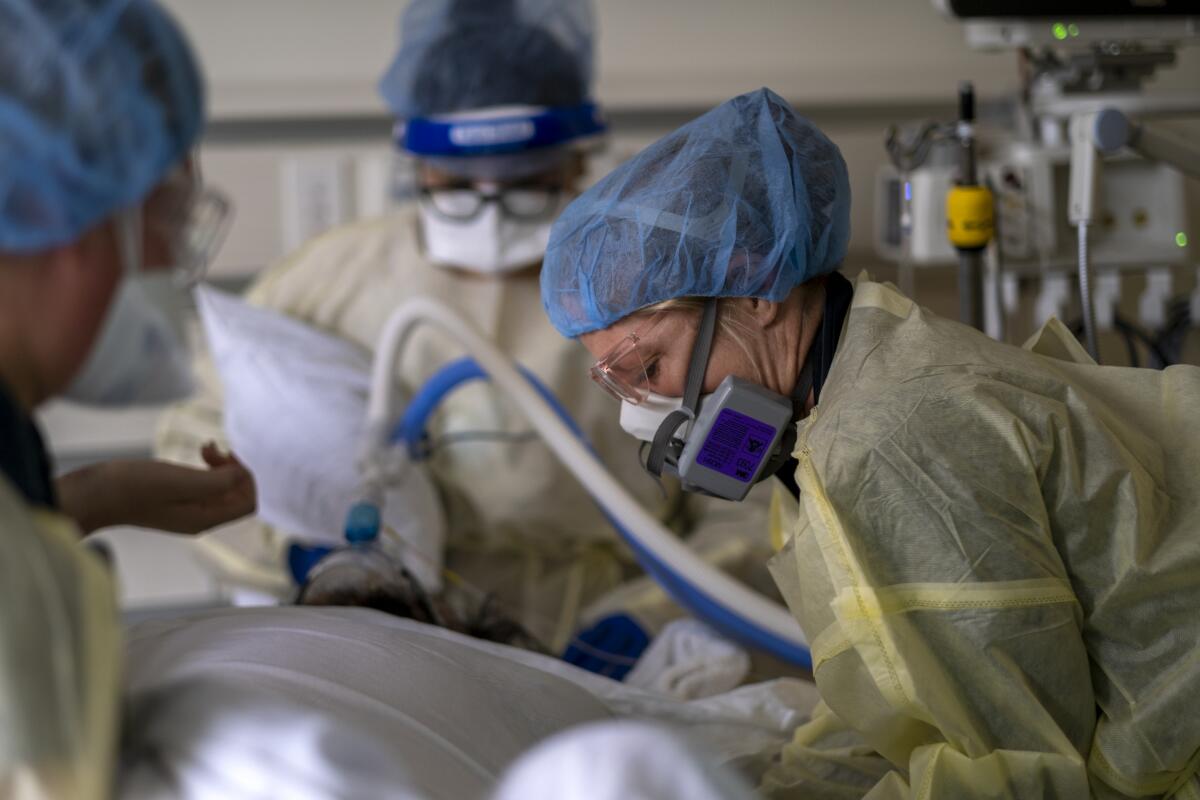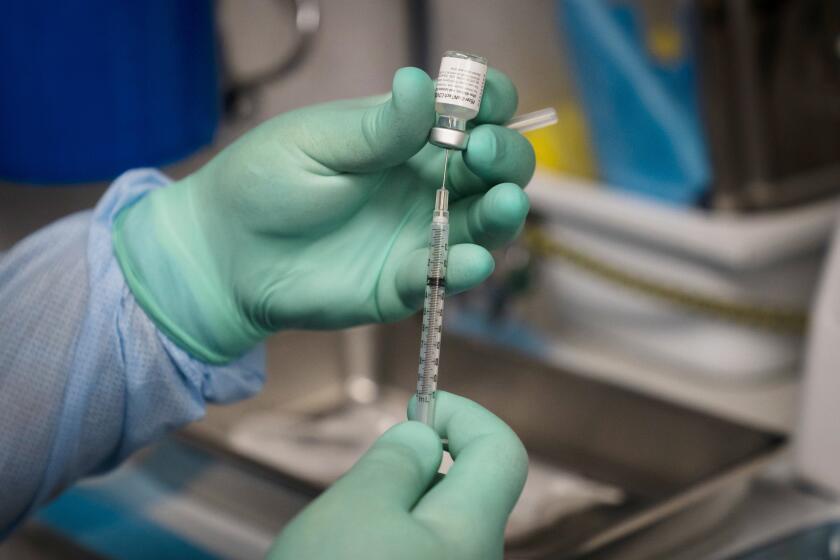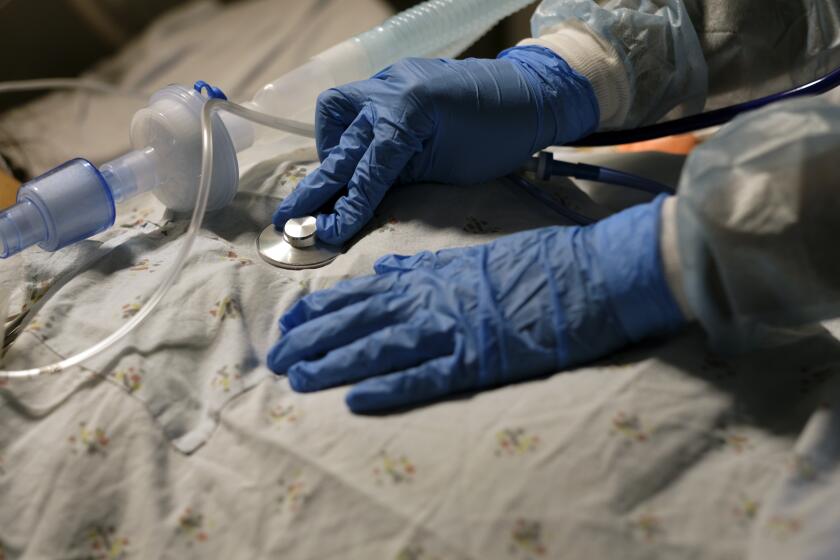Can California avoid another COVID-19 surge? Britain offers a sober warning

- Share via
California’s overall pandemic trends appear to be improving, led especially by declining hospitalizations in Southern California and the Bay Area, although hospitals in the Central Valley and the rural north remain under terrible strain.
But as some health officials have been warning, the improvements are not guaranteed to last.
In late July, Britain celebrated what seemed to be a recovery from its own Delta surge, an improvement that came about six weeks before California began having its drop in cases. But cases rose again in the U.K.
“The cautionary tale here is from the United Kingdom, where they had a very similar pattern, with a surge that dropped down across the summer ... which we’re seeing now. But then it went right back up again,” Dr. George Rutherford, a UC San Francisco epidemiologist and infectious disease expert, said at a recent campus forum.
“We need to be careful that this doesn’t happen here,” Rutherford said. “We are at risk for this happening. And it’s going to take some concerted effort to keep it from not happening.”
The vaccines are still having a helpful impact in Britain: The nation is reporting about 36,000 cases a day, below both the peak of about 60,000 new daily cases during the winter surge and the summer peak of about 48,000 cases a day in late July.
Still, the latest numbers in Britain illustrate an uptick from a midsummer low of about 25,000 cases a day around early August.
Daily deaths are rising in the U.K. but are still far lower than they were during the winter surge. At its winter peak, Britain was reporting about 1,300 deaths a day over a weekly period before falling to nearly zero in the late spring; the country is now reporting about 140 deaths a day over a weekly period, according to Johns Hopkins University.
California already is at a disadvantage compared with Britain. The Golden State, while boasting one of the United States’ highest vaccination rates, still lags behind Britain’s shot record. Among Californians of all ages, 58% are fully vaccinated, while in Britain, 65% are fully vaccinated.
The latest model by the University of Washington’s Institute for Health Metrics and Evaluation shows just how uncertain California’s future could be.
Currently, California is reporting an average of 100 COVID-19 deaths a day, significantly worse than the tallies of 20 to 30 deaths a day earlier in the summer, but still far better than the nearly 550 deaths a day recorded at the peak of the pandemic during the winter surge.
In the most likely scenario, if vaccines continue to be distributed at the current pace, daily deaths are expected to remain steady, the institute’s model says. If more people wear masks, daily deaths would decline.
But if all vaccinated people stopped wearing masks, and variants spread even faster than expected, daily deaths could reach 500 a day by mid-November, according to the institute’s model.
With the experience of the U.K., we can’t be complacent, Dr. Ashish Jha, dean of the Brown University School of Public Health, said in a tweet.
New U.S. studies show COVID-19 vaccines remain highly effective against hospitalizations and death
California’s weekly coronavirus case rates continue to improve.
Los Angeles County did not report case numbers on Saturday or Sunday because of a planned upgrade in its processing systems, but the trend heading into the weekend appeared consistent with continued declines in cases.
Between Aug. 27 and Friday, new weekly coronavirus cases have dropped by 36% in the Bay Area, 28% in Southern California, 27% in the Greater Sacramento area, 18% in the San Joaquin Valley and 15% in rural Northern California.
Nonetheless, coronavirus transmission levels remain high, and so are COVID-19 hospitalization levels.
Hospitals in the Central Valley and rural Northern California remain under considerable duress and have the state’s highest rates of hospitalization for COVID-19. For every 100,000 residents, the San Joaquin Valley has 36 people in the hospital with COVID-19; in rural Northern California, there are 32; and in the Greater Sacramento area, there are 27.
By contrast, Southern California’s rate is 15; the Bay Area, 12.
Some experts say that it can be prudent to implement emergency COVID-19 measures, such as indoor mask mandates, when there are five or more COVID-19 hospitalizations for every 100,000 residents.
In Del Norte County, on California’s northern border, more than half of hospitalized patients at the main hospital in Crescent City have COVID-19.
In the San Joaquin Valley, a broad region with more than 4 million people that stretches from Stockton to Bakersfield, available intensive care unit capacity has remained under 10% for 12 consecutive days, and officials in Fresno County have warned they are so overwhelmed that they might have to ration healthcare — choosing who receives lifesaving measures.
Fresno County’s ICUs have been particularly crowded in the last several weeks, filled with 80 to 93 patients — numbers not seen since February. And because hospitals also are caring for non-COVID-19 patients, the crowding has been so extreme that officials have been forced to transfer critically ill patients as far as Sacramento and the Bay Area, about a 170-mile drive away.
Among unvaccinated COVID-19 patients, infection with the Delta variant doubles the risk of needing hospital treatment, a study finds.
Some experts expressed hope that vaccination mandates, or shot-or-test requirements, will boost vaccination rates. Last week, President Biden said employees at companies with at least 100 workers will be required to get vaccinated or submit to weekly testing.
In Los Angeles County, Public Health Director Barbara Ferrer has said the pace of vaccinations needs to rise much more. But she expressed hope that targeted vaccination orders will help, such as the one that children 12 and older in Los Angeles public schools be fully vaccinated against COVID-19 by January to enter campus.
“There’s just an obligation for us to really try to stop the continued pandemic, and vaccinations are the most powerful tool we have,” Ferrer said.
Statewide, Gov. Gavin Newsom’s administration has ordered, with limited exceptions, that healthcare workers must be fully vaccinated by Sept. 30; California school employees also have been ordered to be vaccinated or be tested weekly.
Ongoing studies continue to demonstrate the power of vaccinations. A recent study published by the U.S. Centers for Disease Control and Prevention showed that, compared with vaccinated people, unvaccinated people in areas hit by the Delta surge were 4½ times more likely to contract the coronavirus, 10 times more likely to be hospitalized with COVID-19, and 11 times more likely to die.
More to Read
Sign up for Essential California
The most important California stories and recommendations in your inbox every morning.
You may occasionally receive promotional content from the Los Angeles Times.














